Saint Marys Luton Additions and Alterations
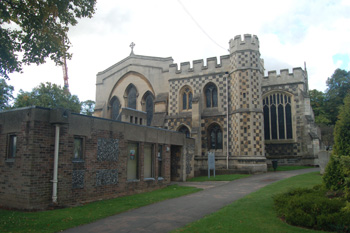
Saint Mary's from the east September 2009
Former County Archivist Chris Pickford wrote a series for Bedfordshire Historical Record Society on Bedfordshire churches in the 19th century, from which this article is derived. The first record of work on the church dates to 1555/6 when ornaments and plate were sold for "the maykynge of an ile of the church" (presumably meaning paving or repair of north or south aisle as both aisles are much older than the 16th century) as well as to buy new ornaments. The antiquary William Camden noted in 1586 that: "the choir [chancel] there [was] roofless and overgrown with weeds". The liability to repair the chancel fell on Trinity College, Oxford, who were compelled by the Court of Exchequer to renovate it early in the 17th century. Various of the church bells were recast in 1602, 1616, 1637 and 1670 and by 1707 there were five bells, a clock and chimes in the tower.
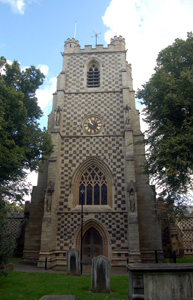
The west tower of Saint Mary's September 2009
By 1721 a gallery was located above the chancel arch and the west end of the chancel and was known as the Hoo Gallery, later the Bute Gallery. It was not taken down until 1855 as it obscured the view of the chancel from the nave. Faculty papers have survived in the Diocesan Archive at Lincoln noting galleries being dismantled in 1691 and 1706 but not where they were. The five bells were again recast in 1727 because they were "of a very extraordinary weight and too heavy for the fabrick" [ABF3/129-130] into six smaller, lighter bells. The tenor bell was again recast in 1761 and in 1775 the other bells were again recast to make a ring of eight. As noted in Bedfordshire Magazine Volume III (page 62) when the founder of Methodism, John Wesley preached at Luton in 1772 he noted in his diary that: "the frost was exceeding sharp, and the glass was taken out of the windows". A chandelier, described in a terrier of 1822, was put into the church around the same time as Wesley preached there. The chancel was re-roofed in the late 18th century and a large Georgian window inserted into the east wall of the chancel. New charity boards were put up in 1781.
![Saint Mary's in 1805 [X254/88/170]](/CommunityHistories/Luton/LutonImages/Saint Marys in 1805 X254-88-170.jpg)
Saint Mary's in 1805 [X254/88/170]
The pews were improved between 1809 and 1813 and in 1819 the font was painted and the chancel arch varnished [P85/25/1/1]. In 1822 the font was moved from the west end of the nave into the south transept, only to be put back in 1866! [P85/2/4/12/12]. New seats were installed in the church between 1823 and 1829 and a west gallery erected in 1823 with an organ in it [P85/25/1/1]. The exterior of the church, including the steeple, were also carried out in the 1820s, having been ordered by the archdeacon. The Someries Chapel was repaired in 1831 and the clock in 1837 [P85/5/1].
![Saint Mary's in 1806 [X376/36]](/CommunityHistories/Luton/LutonImages/Saint Marys in 1806 X376-36.jpg)
Saint Mary's in 1806 [X376/36]
The roof was repaired in 1854 and by this date a number of observers had commented on the poor and neglected appearance of the church, at odds with the evident prosperity of the town at this time. In the 1850s the plaster ceiling in the chancel was removed to expose the wooden beams. The steeple was repaired between 1859 and 1861.
![James O'Neill [P85/28/4/25]](/CommunityHistories/Luton/LutonImages/P85-28-4-25 James ONeill.jpg)
James O'Neill [P85/28/4/25]
In 1863 the energetic new vicar, James O'Neill, began the task, long overdue, of restoring the church. He engaged George Edmund Street as architect who began by repairing the chancel and the east end of the church, paid for by John Sambrooke Crawley of Stockwood, between 1864 and 1865 [P85/2/4]. The organ was moved into the Wenlock Chapel and the church was completely re-seated by 1866 with chairs being used instead of pews. Whilst the church was closed for repairs services were held in a wooden building in Albert Road; in 1866 this was leased out to the Wesleyan Methodists and sold to them a year later, becoming Albert Road Wesleyan Methodist Church. Again in 1866 the Georgian window in the east wall of the chancel was removed and a pair of lancet windows substituted. New choir stalls were introduced between 1867 and 1868. Fragments of the old rood screen were re-assembled as a screen for the Hoo Chapel.
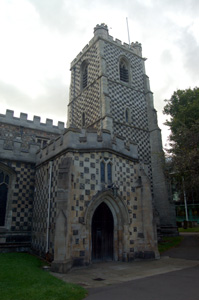
Saint Mary's north porch and west tower September 2009
The north porch was restored in 1874 and work was also carried out in the south transept [P85/5/5] by local architect J. R. Brown. Between 1874 and 1886 stained glass, specially designed by Alexander Gibbs, was installed throughout the church. The windows of the north transept were restored in 1875 and the north porch repaved in 1877 [P85/25/1/11]. The chancel was again repaired between 1876 and 1882 and the south porch was rebuilt between 1879 and 1880 on Street's recommendations [P85/25/1/11], more work was also done on the south transept at this time [P85/5/6]. The last repairs undertaken as part of Street's brief were to the roofs of the north and south aisles between 1880 and 1881 [P85/2/4/17 and P85/25/1/11].
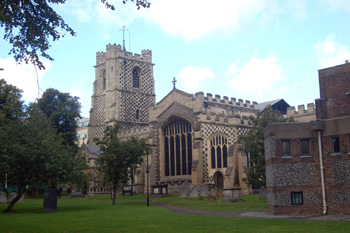
Saint Mary's from the south-east September 2009
The chancel was decorated between 1881 and 1884 including a copy of Leonardo da Vinci's Last Supper in mosaic as a reredos in 1883 [P85/2/11/9]. An alabaster pulpit was installed in the nave to commemorate O'Neil's twentieth year as vicar in 1882 [P85/2/11/9]. In 1893 more stained glass was put into the church, in the windows of the clerestory [P85/30/8], a further window, in O'Neill's memory, being erected in the north transept in 1897 [P85/0/1/4]. The Wenlock Chapel windows were repaired between 1888 and 1889 and the north transept roof repaired between 1892 and 1893. The turrets on the south part of the tower were repaired in 1893 and the vestry and north porch in 1899 [P85/5/8-9]. A new organ was introduced in 1889, rebuilt ten years later and enlarged in 1904 [P85/2/8/3-7].
![Saint Mary's interior about 1910 [X291/83/88]](/CommunityHistories/Luton/LutonImages/Saint Marys interior about 1910 X291-83-88.jpg)
Saint Mary's interior about 1910 [X291/83/88]
As the new century began maintenance work on the church continued; the south aisle and clerestory being repaired between 1899 and 1901 [P85/8/2 and P85/25/1/11] and, in the latter year, the bells were re-hung and the clock replaced [P85/0/1/4]. Giles Gilbert Scott supervised repairs to the Wenlock Chapel between 1904 and 1905 [P85/25/1/11]. The fabric and roofs were restored between 1904 and 1905 [P85/2/4/26-27], the tower in 1907 [P85/5/12/iii] and the chancel between 1912 and 1913 [P85/2/4/29, 31 and 33]. The window above the chancel arch was re-opened in 1906 [P85/30/20]. In 1913 the organ was again rebuilt following a move to the Hoo Chapel, paid for by Sir Julius Wernher [P85/2/5/14] and electricity was installed in the church at the same date. Lady Wernher restored the Someries Chapel as a memorial to Sir Julius between 1913 and 1914 [P85/2/5/15].

The interior looking east about 1910 [X291/186/49]
The clerestory and south aisle were restored between 1928 and 1929 [and the roof between 1936 and 1938 [P85/8/2 and P85/25/1/11]. In 1959 Victorian murals in the sanctuary were removed [P85/2/4/38]. The parish hall and offices were added as a block to the east end of the church between 1968 and 1969, arousing much controversy (not surprisingly as they look like a public toilet and bear no architectural relationship to the church) [P85/2/4/41-45]. In 1979 stained glass was inserted into a window in the south transept [P85/2/9/5] replacing a window damaged by vandalism. The long list of repairs, restorations and alterations in the two hundred years of the 19th and 20th centuries demonstrate, very effectively, the amount of work necessary on a large medieval structure when it is a living building rather than a picturesque ruin.
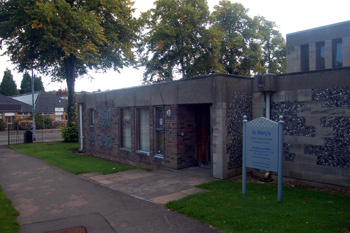 Saint Mary's parish offices September 2009
Saint Mary's parish offices September 2009